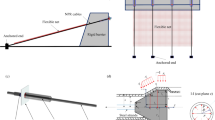Abstract
Bayesian estimation theory was used in this study to establish a state-space model of the ceramic filter tube degradation process. The model continuously integrates the latest residual pressure drop to update its own parameters, then the change rate of the degradation state, remaining life, and failure probability density distribution of the tube in real time. The residual pressure drop of the Shell Coal Gas Process was analyzed to find that the model results converge to real values as the residual pressure drop increases. The change rate of the ceramic filter tube degradation state calculated by the model gradually decreases over time, which is consistent with the initial rapid increase in residual pressure drop followed by a slower increase in later stages of operation. The amount of particle deposition in the ceramic filter tube wall under different operating times was measured and predicted; the predictions are consistent with the state-space model results. The state-space model also reflects variations in filter tube performance degradation caused by emergent conditions such as leakage or fractures, as it does not make stationarity assumptions for the degradation process.
Similar content being viewed by others
References
H. J. Choi, J. U. Kim, H. S. Kim, S. H. Kim and M. H. Lee, Ceram. Int., 41, 10030 (2015).
S. Heidenreich, Fuel, 104, 83 (2013).
B. L. Dou, C. Wang, H. S. Chen, Y. C. Song, B. Z. Xie, Y. J. Xu and C. Q. Tan, Chem. Eng. Res. Des., 90, 1901 (2012).
B. A. Fariñas, M. Lupion, M. R. Galan and J. M. Fernandez, Fuel, 114, 120 (2013).
H. Kamiya, Y. Sekiya and M. Horio, Powder Technol., 115, 139 (2001).
G. Ahmadi and D. H. Smith, Aerosol. Scl. Tech., 36, 665 (2002).
D. H. Smith, V. Powell, G. Ahmadi and E. Ibrahim, Powder Technol., 94, 15 (1997).
N. L. D. Freitas, J. A. S. Goncalves, M. D. M. Innocentini and J. R. Coury, J. Hazard. Mater., 136, 747 (2006).
I. Schildermans, J. Baeyens and K. Smolders, Filter. Sep., 41, 26 (2004).
J. D. Chung, T. W Hwang and S. J. Park, Korean J. Chem. Eng., 20, 1118 (2003).
M. A. Alvin, Fuel Process. Technol., 56, 143 (1998).
H. C. Chi, Z. L. Ji, D. M. Sun and L. S. Cui, Chin. J. Chem. Eng., 17, 219 (2009).
M. Durst, A. Reinhardt and H. Vollmer, Proceedings of the 1st European Symposium on Separation of Particles from Gases (1989).
J. N. Phillips and H. W. A. Dries, Gas cleaning at high temperatures, Springer, Berlin, Germany (1993).
E. Schmidt, Filter. Sep., 34, 365 (1997).
A. C. B. Neiva and L. J. Goldstein, Chem. Eng. Process, 42, 495 (2003).
J. H. Choi, S. J. Ha and H. J. Jang, Powder Technol., 140, 106 (2004).
W. Höflinger, C. Stöcklmyer and A. Hackl, Filter. Sep., 31, 806 (1994).
W. Tanthapanichakoon, T. Charinpanitkul, W. Jintaworn, J. Laksameearunotai, M. Amornkitbamrung, T. Fukui and M. Naito, Powder Technol., 180, 245 (2007).
B. Scheibner and C. Wolters, Proceedings of the 5th International Symposiumon Gas Cleaning at High Temperature (2002).
L. Thomas, J. Royal Statistical Soc., 168, 459 (2005).
Y. W. Wang, Y. Q. Ni and X. Wang, Mech. Syst. Signal. Pr., 139, 51 (2020).
H. T. Lu, W. J. Kolarik and S. S. Lu, IEEE. T. Reliab., 50, 353 (2001).
H. Boudali and J. B. Dugan, Eng. Syst. Saf., 87, 337 (2004).
G. Petris, J. Stat. Softw., 36, 57 (2010).
T. R. Core, Computing, 17, 12 (2015).
D. Spehner, R. Drillien, F. Proamer, D. Hanau and L. Edelmann, J. Microsc-Oxford, 207, 1 (2010).
M. Lupion, B. Navarrete, B. A. Fariñas and M. R. Galan, Fuel, 108, 24 (2013).
J. H. Choi, Y. G. Seo and J. W. Chung, Powder Technol., 114, 129 (2001).
Author information
Authors and Affiliations
Corresponding author
Rights and permissions
About this article
Cite this article
Liu, L. Real-time life and degradation prediction of ceramic filter tube based on state-space model. Korean J. Chem. Eng. 38, 2122–2128 (2021). https://doi.org/10.1007/s11814-021-0854-9
Received:
Revised:
Accepted:
Published:
Issue Date:
DOI: https://doi.org/10.1007/s11814-021-0854-9




